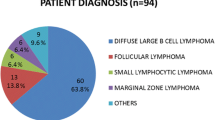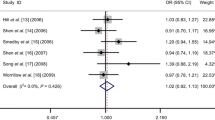Abstract
Several hereditary syndromes characterized by defective DNA repair are associated with high risk of non-Hodgkin lymphoma (NHL). To explore whether common polymorphisms in DNA repair genes affect risk of NHL in the general population, we evaluated the association between single nucleotide polymorphisms (SNPs) in DNA repair genes and risk of NHL in a population-based case–control study among women in Connecticut. A total of 518 NHL cases and 597 controls recruited into the study provided a biologic sample. Thirty-two SNPs in 18 genes involved in several DNA repair pathways were genotyped. Genotype data were analyzed by unconditional logistic regression adjusting for age and race. SNPs in four genes (ERCC5, ERCC2, WRN, and BRCA1) were associated with altered risk of NHL and diffuse large B-cell lymphoma (DLBCL), the major B cell subtype. In particular, ERCC5 Asp1104His was associated with increased risk of NHL overall (OR: 1.46; 95% CI: 1.13–1.88; P = 0.004), DLBCL (OR: 1.44; 95% CI: 0.99–2.09; P = 0.058), and also T cell lymphoma. WRN Cys1367Arg was associated with decreased risk of NHL overall (OR: 0.71; 95% CI: 0.56–0.91; P = 0.007) and DLBCL (OR: 0.66; 95% CI: 0.45–0.95; P = 0.024), as well as follicular and marginal zone lymphomas. Genetic polymorphisms in DNA repair genes, particularly ERCC5 and WRN, may play a role in the pathogenesis of NHL, especially for DLBCL. Further work is needed to extend these findings by carrying out extended haplotype analyses of these and related genes and to replicate the observations in other studies.
Similar content being viewed by others
References
Araujo FD, Pierce AJ, Stark JM, Jasin M (2002) Variant XRCC3 implicated in cancer is functional in homology-directed repair of double-strand breaks. Oncogene 21:4176–4180
Atkin NB (2000) Chromosomal doubling: the significance of polyploidization in the development of human tumors: possibly relevant findings on a lymphoma. Cancer GenetCytogenet 116:81–83
Benjamini Y, Hochberg Y (1995) Controlling the false discovery rate: a practical and powerful approach to multiple testing. J Royal Stat Soc B 57:289–300
Bhatti P, Sigurdson AJ, Wang SS, Chen J, Rothman N, Hartge P, Bergen AW, Landi MT (2005) Genetic variation and willingness to participate in epidemiologic research: data from three studies. Cancer Epidemiol Biomarkers Prev 14:2449–2453
Castro E, Edland SD, Lee L, Ogburn CE, Deeb SS, Brown G, Panduro A, Riestra R, Tilvis R, Louhija J, Penttinen R, Erkkola R, Wang L, Martin GM, Oshima J (2000) Polymorphisms at the Werner locus: II. 1074Leu/Phe, 1367Cys/Arg, longevity, and atherosclerosis. Am J Med Genet 95:374–380
Chaganti RS, Nanjangud G, Schmidt H, Teruya-Feldstein J (2000) Recurring chromosomal abnormalities in non-Hodgkin’s lymphoma: biologic and clinical significance. Semin Hematol 37:396–411
Cheng L, Spitz MR, Hong WK, Wei Q (2000) Reduced expression levels of nucleotide excision repair genes in lung cancer: a case–control analysis. Carcinogenesis 21:1527–1530
Cheng L, Sturgis EM, Eicher SA, Spitz MR, Wei Q (2002) Expression of nucleotide excision repair genes and the risk for squamous cell carcinoma of the head and neck. Cancer 94:393–397
Christmann M, Tomicic MT, Roos WP, Kaina B (2003) Mechanisms of human DNA repair: an update. Toxicology 193:3–34
Clement V, Dunand-Sauthier I, Clarkson SG (2006) Suppression of UV-induced apoptosis by the human DNA repair protein XPG. Cell Death Differ 13:478–488
Garcia-Closas M, Egan KM, Abruzzo J, Newcomb PA, Titus-Ernstoff L, Franklin T, Bender PK, Beck JC, Le Marchand L, Lum A, Alavanja M, Hayes RB, Rutter J, Buetow K, Brinton LA, Rothman N (2001) Collection of genomic DNA from adults in epidemiological studies by buccal cytobrush and mouthwash. Cancer Epidemiol.Biomarkers Prev 10:687–696
Grandori C, Robinson KL, Galloway DA, Swisshelm K (2004) Functional link between Myc and the Werner gene in tumorigenesis. Cell Cycle 3:22–25
Griffin C, Waard H, Deans B, Thacker J (2005) The involvement of key DNA repair pathways in the formation of chromosome rearrangements in embryonic stem cells. DNA Repair (Amst) 4:1019–1027
Hartge P, Wang SS (2004) Overview of the etiology and epidemiology of lymphoma. In: Mauch PM, Armitage JO, Coiffier B, Dalla-Favera R, Harris NL (eds) Non-Hodgkin’s Lymphomas. Lippincott Williams& Wilkins, Philadelphia, pp 711–727
Herrinton LJ (1998) Epidemiology of the revised European–American lymphoma classification subtypes. Epidemiol Rev 20:187–203
Higaki S, Deai T, Fukuda M, Shimomura Y (2004) Microarray analysis in the HSV-1 latently infected mouse trigeminal ganglion. Cornea 23:S42–S47
Hironaka K, Factor VM, Calvisi DF, Conner EA, Thorgeirsson SS (2003) Dysregulation of DNA repair pathways in a transforming growth factor alpha/c-myc transgenic mouse model of accelerated hepatocarcinogenesis. Lab Invest 83:643–654
Jeon HS, Kim KM, Park SH, Lee SY, Choi JE, Lee GY, Kam S, Park RW, Kim IS, Kim CH, Jung TH, Park JY (2003) Relationship between XPG codon 1104 polymorphism and risk of primary lung cancer. Carcinogenesis 24:1677–1681
Kamath-Loeb AS, Welcsh P, Waite M, Adman ET, Loeb LA (2004) The enzymatic activities of the werner syndrome protein are disabled by the amino acid polymorphism, R834C. J Biol Chem 279:55499–55505
Karmakar P, Bohr VA (2005) Cellular dynamics and modulation of WRN protein is DNA damage specific. Mech Ageing Dev 126:1146–1158
Kumar R, Hoglund L, Zhao C, Forsti A, Snellman E, Hemminki K (2003) Single nucleotide polymorphisms in the XPG gene: determination of role in DNA repair and breast cancer risk. Int J Cancer 103:671–675
Matsumoto T, Imamura O, Goto M, Furuichi Y (1998) Characterization of the nuclear localization signal in the DNA helicase involved in Werner’s syndrome. Int J Mol Med 1:71–76
Morton LM, Holford TR, Leaderer B, Zhang Y, Zahm SH, Boyle P, Flynn S, Tallini G, Owens PH, Zhang B, Zheng T (2003) Alcohol use and risk of non-Hodgkin’s lymphoma among Connecticut women (United States). Cancer Causes Control 14:687–694
Ng PC, Henikoff S (2001) Predicting deleterious amino acid substitutions. Genome Res 11:863–874
Ozgenc A, Loeb LA (2005) Current advances in unraveling the function of the Werner syndrome protein. Mutat Res 577:237–251
Packer BR, Yeager M, Staats B, Welch R, Crenshaw A, Kiley M, Eckert A, Beerman M, Miller E, Bergen A, Rothman N, Strausberg R, Chanock SJ (2004) SNP500Cancer: a public resource for sequence validation and assay development for genetic variation in candidate genes. Nucleic Acids Res 32:D528–D532
Palitti F (2004) Mechanisms of formation of chromosomal aberrations: insights from studies with DNA repair-deficient cells. Cytogenet Genome Res 104:95–99
Rosenberg PS, Che A, Chen BE (2005) Multiple hypothesis testing strategies for genetic case–control association studies. Stat Med (Epub ahead of print)
Sakamoto M, Kondo A, Kawasaki K, Goto T, Sakamoto H, Miyake K, Koyamatsu Y, Akiya T, Iwabuchi H, Muroya T, Ochiai K, Tanaka T, Kikuchi Y, Tenjin Y (2001) Analysis of gene expression profiles associated with cisplatin resistance in human ovarian cancer cell lines and tissues using cDNA microarray. Hum Cell 14:305–315
Sarker AH, Tsutakawa SE, Kostek S, Ng C, Shin DS, Peris M, Campeau E, Tainer JA, Nogales E, Cooper PK (2005) Recognition of RNA polymerase II and transcription bubbles by XPG, CSB, and TFIIH: insights for transcription-coupled repair and Cockayne syndrome. Mol Cell 20:187–198
Shiomi N, Mori M, Kito S, Harada YN, Tanaka K, Shiomi T (2005) Severe growth retardation and short life span of double-mutant mice lacking Xpa and exon 15 of Xpg. DNA Repair (Amst) 4:351–357
Wacholder S, Chanock S, Garcia-Closas M, El Ghormli L, Rothman N (2004) Assessing the probability that a positive report is false: an approach for molecular epidemiology studies. J Natl Cancer Inst 96:434–442
Wang N, Akey JM, Zhang K, Chakraborty R, Jin L (2002) Distribution of recombination crossovers and the origin of haplotype blocks: the interplay of population history, recombination, and mutation. Am J Hum Genet 71:1227–1234
Ye L, Miki T, Nakura J, Oshima J, Kamino K, Rakugi H, Ikegami H, Higaki J, Edland SD, Martin GM, Ogihara T (1997) Association of a polymorphic variant of the Werner helicase gene with myocardial infarction in a Japanese population. Am J Med Genet 68:494–498
Yoshihara T, Ishida M, Kinomura A, Katsura M, Tsuruga T, Tashiro S, Asahara T, Miyagawa K (2004) XRCC3 deficiency results in a defect in recombination and increased endoreduplication in human cells. EMBO J 23:670–680
Acknowledgements
This study was supported by the NIH grant CA62006 (T. Zheng) and in part by the Intramural Research Program of the National Institutes of Health (NIH), National Cancer Institute. We thank Dr. Bingshu Eric Chen for the statistical consultation for this study.
Author information
Authors and Affiliations
Corresponding author
Rights and permissions
About this article
Cite this article
Shen, M., Zheng, T., Lan, Q. et al. Polymorphisms in DNA repair genes and risk of non-Hodgkin lymphoma among women in Connecticut. Hum Genet 119, 659–668 (2006). https://doi.org/10.1007/s00439-006-0177-2
Received:
Accepted:
Published:
Issue Date:
DOI: https://doi.org/10.1007/s00439-006-0177-2




